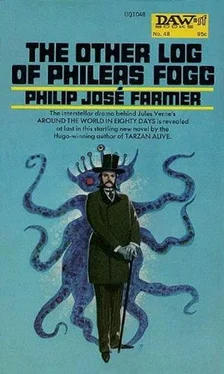Philip Farmer - The Other Log of Phileas Fogg
Здесь есть возможность читать онлайн «Philip Farmer - The Other Log of Phileas Fogg» весь текст электронной книги совершенно бесплатно (целиком полную версию без сокращений). В некоторых случаях можно слушать аудио, скачать через торрент в формате fb2 и присутствует краткое содержание. Жанр: Фантастика и фэнтези, на английском языке. Описание произведения, (предисловие) а так же отзывы посетителей доступны на портале библиотеки ЛибКат.
- Название:The Other Log of Phileas Fogg
- Автор:
- Жанр:
- Год:неизвестен
- ISBN:нет данных
- Рейтинг книги:3 / 5. Голосов: 1
-
Избранное:Добавить в избранное
- Отзывы:
-
Ваша оценка:
- 60
- 1
- 2
- 3
- 4
- 5
The Other Log of Phileas Fogg: краткое содержание, описание и аннотация
Предлагаем к чтению аннотацию, описание, краткое содержание или предисловие (зависит от того, что написал сам автор книги «The Other Log of Phileas Fogg»). Если вы не нашли необходимую информацию о книге — напишите в комментариях, мы постараемся отыскать её.
The Other Log of Phileas Fogg — читать онлайн бесплатно полную книгу (весь текст) целиком
Ниже представлен текст книги, разбитый по страницам. Система сохранения места последней прочитанной страницы, позволяет с удобством читать онлайн бесплатно книгу «The Other Log of Phileas Fogg», без необходимости каждый раз заново искать на чём Вы остановились. Поставьте закладку, и сможете в любой момент перейти на страницу, на которой закончили чтение.
Интервал:
Закладка:
“I saw the upper part of the wheel over the top of this house,” the Frenchman said. “There was no one at it.”
“The ship seems to be deserted except for this Capellean,” Fogg said. “Very strange. But doubtless it can be explained. This seems to be a brigantine. And it’s going on the starboard tack.”
“Pardon, sir?”
“With the wind from the right. The jib and foremast staysails are set on the starboard tack. The ship is headed westward.”
“Jib? Foremast staysail, sir?”
“The headsails. At the front of the ship. The two middle sails, those triangular-shaped ones, attached to the long boom projecting from the nose of the ship. The lower fore-topsail, the fourth from the bottom of the main mast, seems to have been set, but its head has been torn, probably by the wind.
“The foresail and upper fore-topsail are missing. I would judge that they have been blown from the yards. The main staysail, the lowest of the three triangular sails attached between the two masts, is down. It’s that heap on the forward house. The aftersails have been removed. All other sails are furled, even the fore-and-aft sails. The main peak halyards, ropes for lowering and raising the sails, have been broken. Most of them are gone. Before the mainsail can be set, the halyards will have to be repaired. The seas are somewhat heavy, but the ship is not yawing much, that is, changing direction. But we can inspect the ship at a later time. I’m telling you this now so you’ll have some idea of what to do if I don’t return.”
That was not nearly enough for him to know what to do, Passepartout thought.
Fogg, holding the revolver ready, entered the cabin. The open door gave some light. There was a window on the bow end, but it had been covered with a piece of canvas secured by strips of plank nailed into the side of the cabin. The floor was wet, though there was no standing water. This could be accounted for by a heavy sea or rain having come in from somewhere. There was a clock without hands secured upside-down by the two nails to a partition. A table held a slate log and a rack-called by the sailors a fiddle-which kept dishes from sliding off. The rack held dishes but no food or drink was visible nor were there any knives and forks. A piece of canvas evidently used as a towel was on the rack.
Fogg also saw a stove and a swinging lamp.
He looked at the slate log, which would have been used by the chief to make notations while on deck.
“H” stood for the hour; “K,” for knots. Though the log said it was for Monday the twenty-fifth, the date was nautical, not civil. The day would have started on noon of the twenty-fifth, not midnight. The twenty-fifth, for the ship, would end at noon of the twenty-sixth, after which it would be November twenty-sixth.
Today was November twenty-seventh. Something had happened at eight in the morning on the twenty-fifth, or a few hours later, to prevent the mate from continuing the log. When the record ended, the island of St. Mary’s was about six miles to the southwest.

On the port, or left, side of the cabin was the pantry. Fogg, entering it cautiously, found an open box holding moist sugar, a bag with several pounds of tea, an open barrel of flour, an open box of dried herrings, some rice and kidney beans in containers, some pots of preserved fruit, cans of food, and a nutmeg. These were all dry.
Fogg went back into the mate’s cabin and looked around again. On the starboard side was a small bracket holding a tiny vial of oil for, he guessed, a sewing machine. This was still upright. If very heavy seas had been recently met, it would have been thrown to the deck. The bed was dry and showed no damage from water.
He looked under the bed and drew out the ship’s ensign and its private signal: WT. The letter “W” had been sewn on. Also under the bed was a pair of stout sailor’s boots, designed for bad weather but apparently unused. There were also two drawers. One held some pieces of iron and two unbroken panes of glass. The lower drawer held a pair of log sunglasses and a new log reel but no log line.
The next cabin, the last, was the captain’s. He doubted that the sailor was in it. If he had entered it, he surely would have made his presence known by now. However, Fogg entered it slowly, and he kept to the sides of the cabin after he got in. There was a skylight through which the sailor might shoot if he crawled onto the top of the deckhouse.
A harmonium, a reed organ, was by the partition in the center of the cabin. Near it was a number of books, mostly religious, by their titles.
A child’s high chair was on the floor along with a chest containing bottles of medicinals. A compass minus its card was on a table. A portable sewing machine was in a case attached to the bulkhead.
Under a bed, Fogg found a scabbarded sword. He removed it, thinking that he could use it. It seemed to be of Italian make and had probably been an officer’s.
By the port side of the cabin was a water closet. Still cautious, because the sailor might be hiding there in ambush, Fogg looked within. Near the door was a damp bag. It looked as if it might have been wet by rain or spray entering through the half-covered port-hole on the opposite side.
Curious, Fogg entered the closet. He opened the bag and found ladies’ garments, all wet, inside. So the captain had been accompanied by his wife and small child.
The starboard side held two windows, also covered by canvas cut from a sail.
There were no signs of violence anywhere, and the cabin had no aft exit.
Fogg returned to the deck, though not without giving the password first. Passepartout said that the sailor had shown his head around the corner several times but had ducked back each time. Fogg told Passepartout what he had observed. He gave him the pistol, saying, “You hold that man with this. I’ll go back to check on Nemo and inspect the fore deckhouse.”
With the sword in hand, he walked slowly down the starboard side. Though his gait made him a better target for the sailor, he did not believe that it made him a good enough one. What with the wind and the motion of the ship, accuracy was not to be expected from a revolver at this range, Evidently the sailor, if he saw Fogg, had the same thoughts. No shots were fired.
Just before arriving at the fore deckhouse, Fogg went over to the port side. He looked around its corner. Nemo was gone.
Torn strips of sheet were evidence of Nemo’s great strength. He had burst them apart with sheer muscularity. His boots lay by the strips.
Before he had returned on the starboard side, Fogg had looked down the port side. Nemo’s still figure had been on the deck. So, the wily fellow had waited until Fogg was out of sight, because he knew that Passepartout, watching for the sailor, would have his back to him.
Fogg spun around, hoping that Nemo had not passed him going aft ward while he was going forward. But he had. He was running barefoot, as swiftly and as silently as a tiger. He was only about ten feet from the Frenchman’s back.
Fogg gave his first yell in years and ran toward the two. Passepartout, half-deafened, did not hear him. Nemo struck him on the back of his neck with his left fist. The Frenchman was hurled face forward into the deckhouse wall. He crumpled, and Nemo picked up the revolver. Grinning, he turned toward Fogg. Triumphant he might look, but he was pale, and blood ran down his right arm and dripped from his hand. His right arm seemed to be useless, since it hung down at his side and, though right-handed, he held the revolver in his left.
Fogg half-spun to port and raced toward the deckhouse. If Nemo was firing at him he could not hear the reports, but the knowledge that he probably was made him increase his speed. He went around the side of the deckhouse and then to its forepart. Hidden momentarily from the two enemies, he stood there, breathing hard. So now events were suddenly in Nemo’s favor. Passepartout was out of the action, perhaps forever, and Nemo and the sailor each had a revolver.
Читать дальшеИнтервал:
Закладка:
Похожие книги на «The Other Log of Phileas Fogg»
Представляем Вашему вниманию похожие книги на «The Other Log of Phileas Fogg» списком для выбора. Мы отобрали схожую по названию и смыслу литературу в надежде предоставить читателям больше вариантов отыскать новые, интересные, ещё непрочитанные произведения.
Обсуждение, отзывы о книге «The Other Log of Phileas Fogg» и просто собственные мнения читателей. Оставьте ваши комментарии, напишите, что Вы думаете о произведении, его смысле или главных героях. Укажите что конкретно понравилось, а что нет, и почему Вы так считаете.












